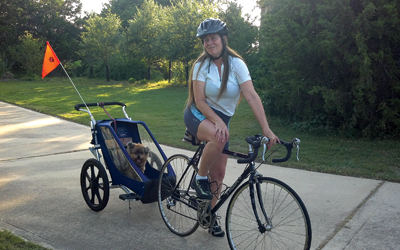I’ve been dancing almost as long as I’ve been walking. I took classes starting at age 2, performed on Funny Bones, a national children’s television program, at age 10, and went on to earn a bachelor’s degree in theater and dance from the University of Southern Mississippi. I always knew that one day I would perform on Broadway.
In 2008, when I was 25, I moved to New York, right on schedule. For eight months, I made real progress toward my goal. Then one evening, after I locked myself out of my apartment, my world spun off its axis.
I have few memories of that night. I do remember making my way to the rooftop to look for a way into my top-floor flat, and, for a moment, I was standing on a solid surface. The next thing I knew, I was in the hospital, my neck and back broken in three different places. Somehow, I had fallen six stories and it wasn’t immediately clear that I would survive.
Based on the nature of my injuries, the doctors who came in and out of my room had grave concerns of whether I’d ever walk again. I wanted to tell them that they were wrong, but at the time, that was impossible. During my first six weeks in the hospital, I couldn’t talk because of a tracheostomy tube in my throat. I dropped 25 pounds from my already lean dancer’s frame.
The situation, and the dire prognosis, could have sent me into a spiral of depression. But I wanted something different for my life. I wanted more.
The Long Road to Recovery
I’m an optimistic person, but those first few weeks and months after the accident were physically and emotionally grueling. It was hard for me to go from being completely self-sufficient to having someone I’d never met giving me a shower. I was utterly vulnerable.
I had a mantra that kept me going, though. “This too shall pass,” I told myself over and over. “These bad things I’m feeling right now, they’re not going to last forever.” Those simple words not only helped me get through each day, they got me from moment to moment.
A month after the accident, I was transferred to a Mississippi hospital, weaned off the ventilator, and sent to a facility for my rehab. Still, time crawled by and, because of my natural inclination toward impatience, it sometimes felt like my worst enemy. I had to constantly remind myself that, even when I couldn’t see day-to-day improvement, I really was getting better. Only when I look back now do I realize the progress happened much faster than it felt like at the time.
Four months after the accident, I began to get around with the aid of a walker. It was exciting to be able to do something that the doctors had feared I’d never do, and I knew I had to believe in myself or I wouldn’t advance.
In rehab I often spent hours repeating the smallest skills over and over. As a performer, I was familiar with this because the same is true of dancing. You can’t just go through the motions. You’ve got to truly focus on the task at hand to get better, whether it’s choreographing a movement or just moving your leg up and down. I treated my daily rehab the same way that I treated my dance classes. I never arrived late and I worked hard the whole time.
In acting class, I had learned the Suzuki Method, which helps people build awareness of themselves and the movements they make. One of the exercises, for example, is imagining your pelvis moving through space as though a rope is around your waist and someone is pulling it. Somehow, being more aware of where I was in the space around me really made a difference.
Rehab was a roller coaster. But within two years, I was able to move out of my parents’ house and live more independently. I no longer needed to use a walker or a cane, I retrained myself to write legibly, and I started cooking on my own.
Still, because of blocked receptors in my spine, I wasn’t able to sweat. It might sound great, but I felt like a furnace. I was excited when I started perspiring more this past year. (I couldn’t wait to go buy deodorant!) Sometimes, progress is just plain weird. I’ve tried to have a sense of humor and perspective during the process, and it’s made a real difference.
Last year, for instance, I started walking in heels (OK, wedges). That was a big deal. I’ve often missed feeling feminine and confident, and this small step up helped a lot.
Rediscovering Purpose
Before the accident, I had a single, overarching goal for my life. When it was derailed, I had no choice but to reevaluate everything. “Broadway” was the simple way to describe what I wanted, but when I dug deeper, I understood that what that word really represented was a desire to perform and reach out to people. And I realized that was something I could still do. I just needed to think more broadly about how.
In 2011 I got my first TV gig promoting NewYork–Presbyterian Hospital, where I spent my first month after the accident. I now travel the country speaking to groups about my accident and recovery. And I work with medical providers and patients with catastrophic injuries to help them communicate more effectively with each other and ease the recovery process.
I’m not willing to give up on my longtime goal — to dance, maybe even on the big stage in New York City. But these days, I’m more willing to take things as they come. There have been a lot of bumps in the road, but I’m always thinking about how I can improve my situation and keep pushing ahead.
Success Summary
Meet: Nicole Marquez, 30, motivational speaker, Jackson, Miss.
Big Achievement: Living an independent and meaningful life after breaking her neck and back in a near-fatal accident.
Big Inspiration: Regaining the strong and capable body she had before the accident.
What Worked: Building a community of support for a long journey. “I have an amazing group of family and friends. And I always thank my doctors and therapists. They’ve seen more in me than I knew I had.”
What Didn’t: Expecting pity. “What’s done is done. You can’t turn back the clock, so you just need to figure out how to get where you want to be.”
Words of Wisdom: Think of yourself as a work in progress. “We all take things for granted until there’s a glitch. But that just means it’s time to go back in and rework things. No matter how far you have to go, you can still tweak and twist and fix and tighten.”




This Post Has 2 Comments
Yours is a truly remarkable story. I just saw you on a PBS show. I can’t think of anyone who is more positive, impressive or together.
You truly are an inspiration.
I saw you on a segment of the cooking show Fit to eat. I think you are an inspiration to many as your long and painstaking road to recovery must have been difficult, but you kept it up. I know that God was guiding you and he is the one we must always give thanks to. God Bless you and much success and good health to you.🙏